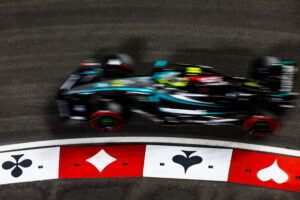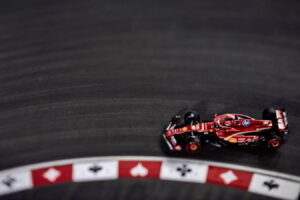IndyCar qualifying works differently between road/street courses, ovals, and the Indianapolis 500.
Road and street courses
Since the IndyCar grid can average around 27 cars, they have to split drivers into two starting groups in qualifying. The officials split them up into two groups of around 12-15 drivers. The two groups are decided by their times in the second practice session.
In the first segment, group one will go out and complete a ten-minute session with the six fastest moving on to the next phase. Next, group two completes their ten-minute session with the same rules applying. The eliminated IndyCar drivers from groups one and two (13th place and beyond) have their grid slots set based on even and odd numbers.
Segment 2 of IndyCar qualifying a.k.a the “fast twelve” involves the twelve advancing cars from segment one. They complete a ten-minute session(cautions included) and the six fastest drivers move on. The remaining driver’s starting positions are determined by their fastest lap times.
The final part of this IndyCar qualifying format is the Firestone Fast Six. This is the six advancing drivers who get a guaranteed six minutes of track time. Once the session is over, the fastest driver gets pole position with the remaining grid slots being set via the fastest lap times.
Ovals
Unlike the road and street courses, IndyCar qualifying at ovals is much less complicated. Due to the ultra-high speed and dangerous nature of IndyCars in qualifying trim on ovals, they do not go out in groups.
The drivers go out one by one in reverse order of their championship points. If there is an entrant that has no points, they start at the front of the line.
Each driver will enter the track and complete two out-laps and two flying laps. Their fastest average speed from the two flying laps determines their grid slot. The driver who has the overall fastest aggregate speed gets the NTT P1 award.
Following this, there are a couple of side notes. The drivers entering the sessions can leave the staging pit once and only once.
Indianapolis 500 Day 1
May is special. May is yours. And in 90 days, May is OURS.#IsItMayYet?
🎟 >>> https://t.co/V5svQ6qSUR#Indy500 | #INDYCAR pic.twitter.com/qyGzV5AxTF
— Indianapolis Motor Speedway (@IMS) February 26, 2024
IndyCar qualifying for the Greatest Spectacle in Racing is a whole separate animal compared to other oval races. It is a two-day occasion with a big difference from normal oval qualifying. That key difference is that each driver will get their position via the average speed from four flying laps, not two.
On the first day, qualifying for positions 1-30 takes place. The drivers who place in positions 13-30 get their grid positions locked in and do not need to take part the next day.
What’s more, the drivers who do not make it into the top 30 spots have to wait until the next day for something called Last Chance Qualifying.
Indianapolis 500 Day 2
Correspondingly, day two of Indy 500 qualifying has its own unique set of procedures and sessions. The first one is called Top 12 Qualifying.
Similar to road/street course qualifying, the fastest six drivers advance to the Firestone Fast Six. The remaining drivers (positions 7-12) get their lap times set in order of the fastest aggregate speed.
In addition, there is Last Chance Qualifying. This is the session that determines positions 31-33. Consequently, drivers who fall below position 33 do not qualify for the race.
Finally, day two concludes with the Firestone Fast Six. The NTT P1 award goes to the driver with the fastest aggregate speed.
Slightly Confusing but effective
While IndyCar qualifying can seem confusing on the surface, it makes sense in the long run. IndyCar has used this system for some time and it works.






